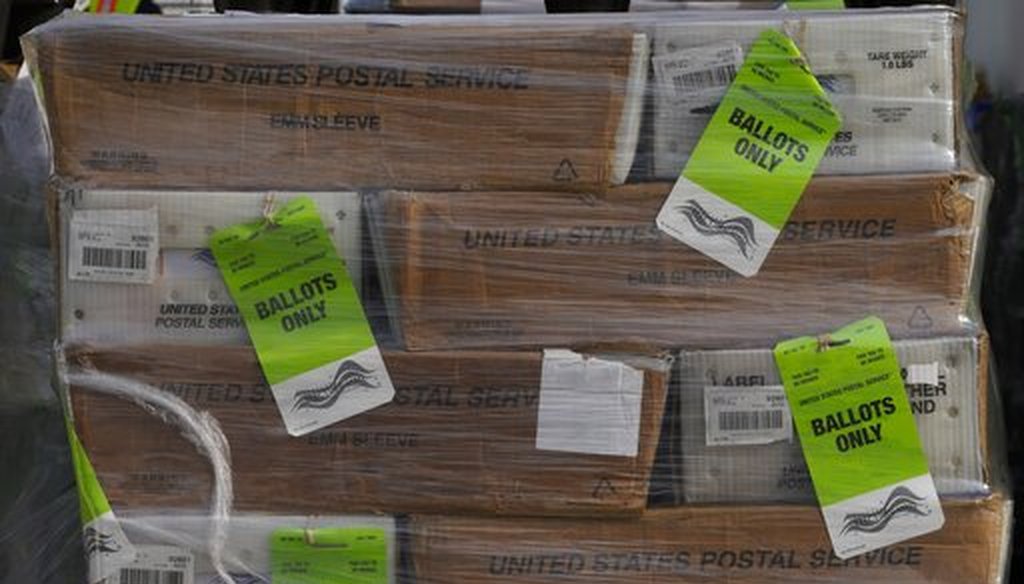



Pallets of ballots ready to be mailed were displayed in Orange County, Calif., on Oct. 5 (AP)
The statement is based on an analysis that claims 440,000 ballots were sent to people who have "likely" moved or died, or appear to be registered twice.
For the vast majority of the 440,000, the analysis indicates those people have not voted in the past 12 years or have not moved, not that they are ineligible to vote.
California has measures in place to guard against sending ballots or counting ballots sent to people who may have moved or died.
A post on Instagram with the word FRAUD emblazoned at the top makes this statement:
"Voter fraud? California sends 440,000 ballots to ineligible voters."
President Donald Trump seized on the claim on Twitter, exclaiming: "Rigged Election!"
The Instagram post was flagged as part of Facebook’s efforts to combat false news and misinformation on its News Feed. (Read more about our partnership with Facebook, which owns Instagram.)
An analysis that the post relies on does not cite any evidence of fraud or rigging. And while it suggests some voter registrations may be out of date, it doesn’t show that 440,000 on the registered voter list are ineligible to vote.
Citing the COVID-19 pandemic, Gov. Gavin Newsom ordered that ballots for the Nov. 3 general election be mailed to all registered California voters. About 21 million ballots were sent in early October.
The analysis cited in the Instagram post was done by Election Integrity Project California, a watchdog group that scrutinizes voter registration records. The analysis is detailed in an Oct. 17 letter to the California Secretary of State’s Office.
The letter says the project’s review of California voter registration files as of Aug. 18 found that the vast majority of the 440,000 — 416,633 people — were registered on or before Nov. 4, 2008, and have not voted or updated their registrations since then. The letter concludes that those voters have "likely" died or moved.
But if the group’s numbers are correct, it means only that those people haven’t voted in recent elections and haven’t changed addresses within California — not that they are ineligible to vote. How many of those people might be ineligible has not been established.
In the past several presidential elections, about 20% to 25% of registered California voters did not cast a ballot, according to data compiled by the California Secretary of State’s office, and participation tends to be far lower in other elections. The 416,633 voters cited by the analysis account for about 2% of California’s roughly 21 million registered voters.
The analysis also said that another 3,342 names match a state Death Index record; and 19,802 people who appear to be registered twice and "likely" were mailed two ballots.
Michael Wexler, an attorney for the Election Integrity Project California, told PolitiFact that the Instagram post’s use of the word ineligible "reasonably comprises the names of voters who are deceased (hence no longer eligible to vote anywhere) or no longer reside at the registration address (hence not eligible to vote there)."
The letter is essentially a new version of an April 28 letter that used a slightly higher number, 458,895.
Here’s what we found when we reviewed the earlier letter:
Election officials acknowledge that some ballots are mailed erroneously to ineligible voters, given the lag time between a voter moving or dying and the receipt of official notices.
Ongoing maintenance of voter rolls includes updates of death records from the Department of Public Health weekly and change-of-address information from the Division of Motor Vehicles daily. So election experts said they strongly doubt so many ballots would go to Californians who died or moved.
Justin Levitt, associate dean for research at Loyola Law School in Los Angeles, where he teaches constitutional law with a focus on election administration, said: "Even if there are some registration records that are not perfectly accurate, that does not mean that they will be used to cast ballots that are counted. There are plenty of other safeguards in the process to make sure that individual ballots are not counted if they happen to be cast on behalf of people who have died or moved, including a signature-matching system that is rather vigorous."
A post on Instagram claims that California sends 440,000 ballots to ineligible voters, and raises the specter of voter fraud.
The analysis that the post is based on cites no evidence of fraud and provides no evidence that California sent 440,000 ballots for the general election to ineligible voters.
We rate the statement False.
This fact check is available at IFCN’s 2020 US Elections FactChat #Chatbot on WhatsApp. Click here, for more.
Instagram, post (archived here), Oct. 21, 2020
Election Integrity Project California, letter to the California Secretary of State’s Office, Oct. 17, 2020
Election Integrity Project California, letter to the California Secretary of State’s Office, April 28, 2020
PolitiFact, "Will 458,000 Vote-By-Mail Ballots Go To Californians Who Have Died Or Moved? Experts Are Skeptical," July 3, 2020
Email, Election Integrity Project California attorney Michael Wexler, Oct. 22, 2020
In a world of wild talk and fake news, help us stand up for the facts.
